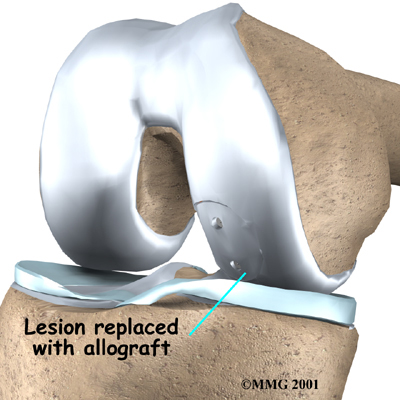Introduction
Physiotherapy in Hamilton West Mountain & Ancaster for Knee
Welcome to Westmount Physiotherapy's patient resource about Articular Cartilage Problems of the Knee.
Articular cartilage problems in the knee joint are common. Injured areas, called lesions, often show up as tears or pot holes in the surface of the cartilage. If a tear goes all the way through the cartilage, surgeons call it a full-thickness lesion. When this happens, surgery is usually recommended. However, these operations are challenging. Repair and rehabilitation are difficult. Your surgeon will consider many factors when determining the procedure that's best for you.
This guide will help you understand:
- what your surgeon hopes to achieve
- what happens during the procedure
- what to expect after surgery
#testimonialslist|kind:all|display:slider|orderby:type|filter_utags_names:Knee Pain|limit:15|heading:Hear from some of our patients who we treated for *Knee Pain*#
Anatomy
Where is the articular cartilage, and what does it do?
Articular cartilage covers the ends of bones. It has a smooth, slippery surface, which allows the bones of the knee joint to slide over each other without rubbing. This slick surface is designed to minimize pressure and friction as you move.
When the surface of the cartilage is injured, it is usually not painful at first. This is because cartilage tissues are not supplied with nerves. However, any holes or rough spots in the cartilage can throw off the intricate design of the joint. If this happens, the joint can become inflamed and painful. If the injury, or lesion, is large enough, the bone below the cartilage loses protection, and pressure and strain on this unprotected portion of the bone can also become a source of pain. Finally, if the cartilage injury isn't treated, it may eventually cause other problems in the joint.
Surgeons classify defects in the knee cartilage using a grading scale from I (one) to IV (four). In a grade I tear, the cartilage has a soft spot. Grade II lesions show minor tears in the surface of the cartilage. Grade III lesions have deep crevices. In grade IV lesions, the tear goes all the way to the underlying bone.
The following images show each type of defect
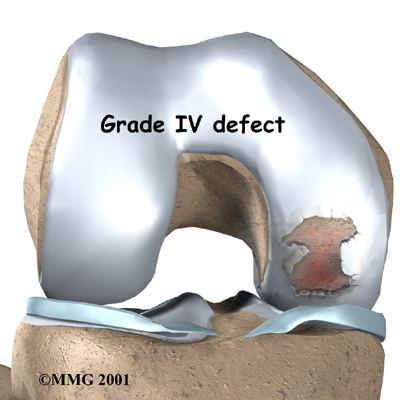
A grade IV lesion goes completely through of the cartilage. It is diagnosed as a full-thickness lesion. Sometimes part of the torn cartilage will break off inside the joint. Since it is no longer attached to the bone, it can begin to move around within the joint, causing even more damage to the surface of the cartilage. Some doctors refer to this unattached piece as a loose body.
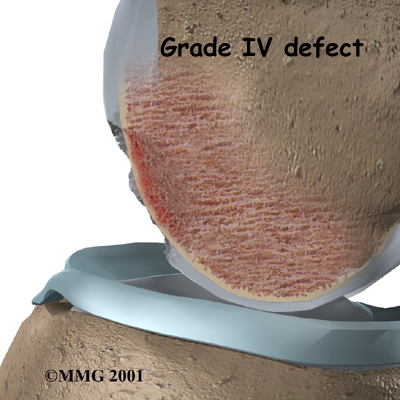
Cartilage lacks a supply of blood or lymph vessels, which normally nourish other parts of the body. Without a direct supply of nourishment, cartilage is not able to heal itself if it gets injured. If the cartilage is torn all the way down to the bone, however, the blood supply from inside the bone is sometimes enough to start some healing inside the lesion. In cases like this, the body will form a scar in the area using a special type of cartilage called fibrocartilage. Fibrocartilage is a tough, dense, fibrous material that helps fill in the torn part of the cartilage. Yet it's not an ideal replacement for the smooth, glassy articular cartilage that normally covers the surface of the knee joint.
Related Document: Westmount Physiotherapy's Guide to Knee Anatomy
Knee Anatomy Introduction
Rationale
What does the surgeon hope to accomplish?
Articular cartilage lesions do not always cause symptoms. In fact, surgeons many times happen upon lesions in the knee joint cartilage while doing knee surgery for a completely different problem. Just because there isn't any pain does not mean the lesion is not causing problems. In general, partially torn lesions do not heal by themselves. And they often get worse over time, not better.
Likewise, full-thickness lesions may not cause any symptoms at first. The fibrocartilage that fills in the injured space often doesn't match the shape of the joint surface. The body may have problems adapting to the altered shape of the joint, which can eventually even change the way the joint works.
When the lesion causes pain, surgery will most likely be recommended. If the lesion is not causing symptoms, there is less certainty about what to do. Will surgery help? Or could it make the situation worse? In these cases, surgeons will weigh many factors before recommending surgery, such as the patient's age and lifestyle, the overall condition of the knee, and how bad the lesion actually is.
Even if patients have pain, they may not have surgery right away. Doctors may start by recommending ways to manage the symptoms. This could be as simple as applying heat or ice and taking prescription medication. Often, doctors will recommend patients work with a physiotherapist. A knee brace or shoe orthotic may be issued to improve knee alignment to ease pressure on the sore knee.
Preparation
What should I expect before surgery?
Before surgery, your surgeon will need to find out as much as possible about your knee. In addition to your physical exam, you will need more X-rays and possibly other imaging tests, such as magnetic resonance imaging (MRI) and bone scans. Your surgeon may also need to use an arthroscope (discussed later) to check the lesion's location, size, and depth.
Surgical Procedure
What happens during surgery?
Many types of surgery have been developed for fixing articular cartilage injuries in the knee. When the decision is made to go ahead with surgery, the surgeon will consider whether to do a procedure to restore or to repair the cartilage. A reparative surgery can help fill in the lesion, but it doesn't completely restore the actual makeup and function of the original cartilage. (Sometimes that simply isn't possible given the amount of damage in the knee.) Reparative procedures may provide pain relief and improve knee motion and function.
Your surgeon would ideally like to help your knee return to its natural state, with full function and no pain. This requires restorative surgery, meaning that the end result is a lesion filled to the full depth by tissue identical to the original. Surgeons rely on some fairly new procedures to substitute or replace the original cartilage. One method is to transplant cartilage and underlying bone from a nearby area in the knee joint. Another method is to take some chondrocytes (the primary cells of cartilage) from your knee cartilage, grow them in a laboratory, and then use the newly grown tissue to fill in the lesion at a later date.
The final decision about which surgery to use will be based on your specific injury, age, activity level, and the overall condition of your knee.
Reparative Surgery: Cell Stimulation Methods
These procedures are used to stimulate the body to begin healing the injury. They are considered reparative surgeries because the lesion mainly fills in with fibrocartilage.
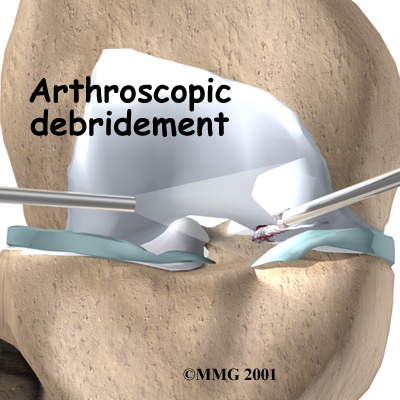 Arthroscopic Debridement
Arthroscopic Debridement
Surgeons use an arthroscope, a tiny camera inserted into the knee during surgery, to see into the joint and clean up the joint by . Sometimes this procedure is referred to as chondroplasty.
It is only intended to be a short-term solution, but it is often successful in relieving symptoms for a few years. This procedure is usually used when the lesion is too large for a grafting type procedure or the patient is older and an artificial knee is planned for the future.
Abrasion Arthroplasty
When osteoarthritis affects a joint, the articular cartilage can wear away, leaving bone rubbing on bone.
This causes the bone to become hard and polished. During arthroscopy the surgeon can use a special instrument known as a burr to perform an . In this procedure, the surgeon carefully scrapes off the hard, polished bone tissue from the surface of the joint. The scraping action causes a healing response in the bone. In time new blood vessels enter the area and fill it with scar tissue (fibrocartilage) that is like articular cartilage. Fibrocartilage is weaker than normal articular cartilage. Because this is not true articular cartilage, it does not function as well for weight bearing as articular cartilage. The fibrocartilage that forms may not be strong enough to remove all the symptoms of pain in the knee. This usually is a temporary solution. Symptoms may return after this surgery.
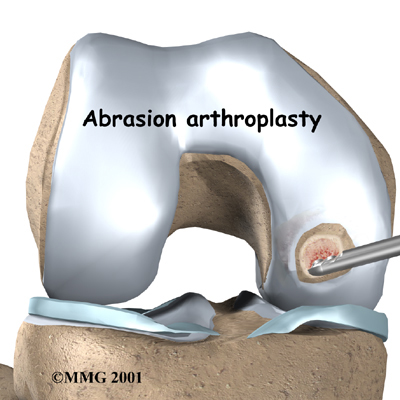
Microfracture
Surgeons use a blunt awl (a tool for making small holes) to poke a few tiny holes in the bone under the cartilage. Like abrasion arthroplasty, is used to get the layer of bone under the cartilage to produce a healing response. The fresh blood supply starts the healing response and triggers the body to start forming new cartilage (mainly fibrocartilage) inside the lesion.
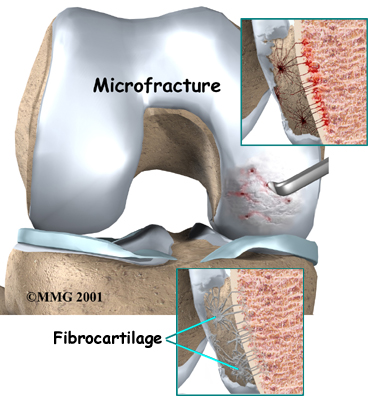
Restorative Surgery: Substitution and Replacement Methods
In these procedures, tissue is placed inside the lesion in hopes of restoring the normal structure and function of the original cartilage. The stimulation methods and these newer procedures are showing improved results in helping people return to normal activity.
Periosteal and Perichondral Grafting
Experiments have been done to implant tissues from the covering of bone and cartilage into the lesion. Few of these surgeries have actually been done in humans. The results are promising because the cartilage that forms tends to be articular cartilage, rather than fibrocartilage. These procedures are still in the experimental stage, but they could eventually become a way for surgeons to restore articular cartilage.
Autologous Chondrocyte Implantation
This is a new way to help restore the structural makeup of the articular cartilage. Surgeons may recommend this procedure for active, younger patients (20 to 50 years old) when the bone under the lesion hasn't been badly damaged, and when the size of the lesion is small (less than four centimeters in diameter). A short surgery is scheduled to allow the surgeon to take a few chondrocytes from inside the knee cartilage. These cells are grown in a laboratory. At a later date, the patient returns for a second surgery, during which the surgeon implants the newly grown cartilage into the lesion and covers it with a small flap of tissue. The cover holds the cells in place while they attach themselves to the surrounding cartilage and begin to heal.
Osteochondral Autograft
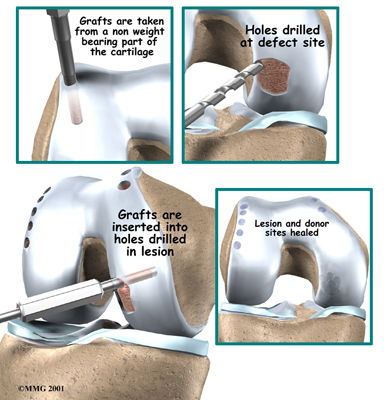 An autograft is a procedure for grafting tissue from the patient's own body. The place where the graft is taken is called the donor site. In this case, surgeons graft a small amount of bone (osteo) and cartilage (chondral) from the donor site to put into the lesion. Usually, the donor site for this procedure is on the joint surface of the injured knee. Surgeons are careful to take the graft from a spot that won't cause a lot of problems, usually on the top and outside border of the knee cartilage. Even then, people sometimes end up with problems around the donor site. The procedure has mostly been used to treat osteochondritis dissecans (OCD), a condition where a chunk of the cartilage and the layer of bone beneath have died.
An autograft is a procedure for grafting tissue from the patient's own body. The place where the graft is taken is called the donor site. In this case, surgeons graft a small amount of bone (osteo) and cartilage (chondral) from the donor site to put into the lesion. Usually, the donor site for this procedure is on the joint surface of the injured knee. Surgeons are careful to take the graft from a spot that won't cause a lot of problems, usually on the top and outside border of the knee cartilage. Even then, people sometimes end up with problems around the donor site. The procedure has mostly been used to treat osteochondritis dissecans (OCD), a condition where a chunk of the cartilage and the layer of bone beneath have died.
The fragment often gets dislodged and becomes a loose body in the joint. Surgeons have gotten good results with this surgery, but it is challenging to contour the graft to be just the same shape as the covering of the joint.
Related Document: Westmount Physiotherapys Guide to Osteochondritis Dissecans of the Knee
Osteochondral Allograft
An osteochondral allograft is a lot like the osteochondral autograft described above. But instead of taking tissue from the patient's donor site, surgeons rely on tissue from another person, much like using donor hearts, kidneys, and other organs. The procedure is mostly used for OCD after other surgeries have failed. It is not recommended for patients with osteoarthritis. One of the problems with this kind of procedure is the limited supply of donor tissue. Even though there are technical difficulties with this type of surgery, the success rate is generally high. This procedure usually involves placing rather large pieces of cartilage and bone in the joint. The allograft is usually held in place with metal screws or pins.
Complications
What might go wrong?
As with all major surgical procedures, complications can occur. This document doesn't provide a complete list of the possible complications, but it does highlight some of the most common problems. Some of the most common complications following articular cartilage surgery are:
- anesthesia complications
- thrombophlebitis
- infection
- hardware failure
- failure of surgery
Anesthesia Complications
Most surgical procedures require that some type of anesthesia be done before surgery. A very small number of patients have problems with anesthesia. These problems can be reactions to the drugs used, problems related to other medical complications, and problems due to the anesthesia. Be sure to discuss the risks and your concerns with your anesthesiologist.
Thrombophlebitis (Blood Clots)
Thrombophlebitis, sometimes called deep venous thrombosis (DVT), can occur after any operation, but is more likely to occur following surgery on the hip, pelvis, or knee. DVT occurs when blood clots form in the large veins of the leg. This may cause the leg to swell and become warm to the touch and painful. If the blood clots in the veins break apart, they can travel to the lung, where they lodge in the capillaries and cut off the blood supply to a portion of the lung. This is called a pulmonary embolism. (Pulmonary means lung, and embolism refers to a fragment of something traveling through the vascular system.) Most surgeons take preventing DVT very seriously. There are many ways to reduce the risk of DVT, but probably the most effective is getting you moving as soon as possible after surgery. Two other commonly used preventative measures include:
- pressure stockings to keep the blood in the legs moving
- medications that thin the blood and prevent blood clots from forming
Infection
Any time surgery is performed there is a risk of infection. The infection can be only in the skin incision or it can spread deeper to involve the joint. A wound infection that only involves the skin incision is considered a superficial infection. It is less serious and easier to treat than a deeper infection. Surgeons take every precaution to prevent infections. You will probably be given antibiotics right before surgery, especially if bone graft or metal screws or plates will be used for your surgery. This is to help reduce the risk of infection.
If the surgical wound or the joint becomes red, hot, and swollen, and if it does not heal, it may be infected. Infections usually cause increasing pain. You may run a fever and have shaking chills. The wound may ooze clear liquid or yellow pus. The drainage may smell bad.
Contact your surgeon immediately so the wound can be treated and antibiotic medication can be prescribed if necessary. A superficial wound infection can usually be treated with antibiotics (and perhaps removing the skin stitches). Deeper wound infections can be very serious and will probably require additional operations to drain the infection. In the worst cases, any bone graft and metal screws and plates that were used may need to be removed.
Hardware Failure
In many different types of joint operations, metal pins or screws are used as part of the procedure. These metal devices are called hardware. Once the bone heals, the hardware is usually not doing much of anything. Sometimes before the surgery is completely healed the hardware either breaks or moves from its correct position. This is called a hardware failure. Hardware failures may require a second operation to either remove or replace the hardware.
Failure of Surgery
In some cases, surgery doesn't relieve symptoms in the way the patient expected. In rare cases, surgery can even create new problems in your joints. This is especially true when you are trying an experimental surgery or have a very injured joint.
After Surgery
What happens after surgery?
After surgery, patients go to the post-anesthesia care unit (PACU) for specialized care until they awaken. Then they are either transferred to the nursing unit or released from the hospital. Many of the procedures for treating articular cartilage are done on an outpatient basis, meaning you can leave the hospital the same day.
Since surgeons use different methods when treating articular cartilage lesions in the knee, the instructions patients need to follow after surgery depend on the surgeon and the way the surgery was done.
Portions of this document copyright MMG, LLC.
Our Rehabilitation
What should I expect during my recovery?
When you begin your physiotherapy at Westmount Physiotherapy, our first few physiotherapy treatments are designed to help control the pain and swelling from the surgery. We will also work with you to make sure you only put a safe amount of weight on the affected leg.
With the exception of those who undergo a simple debridement, our patients will be instructed to avoid putting too much weight on their foot when standing or walking for up to six weeks. This gives the area time to heal. Our patients treated with an allograft are often restricted in their weight bearing for up to four months.
We strongly advise you to follow our recommendations about how much weight is safe. You may require a walker or pair of crutches for up to six weeks to avoid putting too much pressure on the joint when you are up and about.
Depending on the type of surgery, our physiotherapist may have you use a continuous passive motion (CPM) machine to help your knee begin to move and to alleviate joint stiffness. This machine is used after many different types of surgery involving joints and is usually started immediately after surgery. The machine straps to the leg and continuously bends and straightens the joint. This continuous motion has been shown to reduce stiffness, reduce pain, and help the joint surface heal better with less scarring.
Your physiotherapist will choose exercises to help improve knee motion and to get your muscles toned and active again. At first, we will place emphasis on exercising the knee in positions and movements that don't strain the healing part of the cartilage. As your program evolves, we will choose more challenging exercises to safely advance the knee's strength and function.
Ideally, patients will be able to resume their previous lifestyle activities. Some patients may be encouraged to modify their activity choices, especially if an allograft procedure was used.
At Westmount Physiotherapy, our goal is to help you keep your pain under control, ensure safe weight bearing, and improve your strength and range of motion. When your recovery is well under way, regular visits to our office will end. Although we will continue to be a resource, you will be in charge of doing your exercises as part of an ongoing home program.
Westmount Physiotherapy provides services for physiotherapy in Hamilton West Mountain & Ancaster.
Portions of this document copyright MMG, LLC.
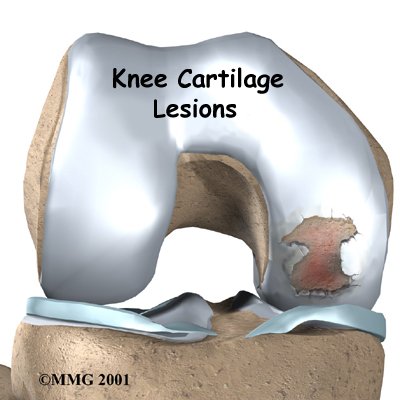









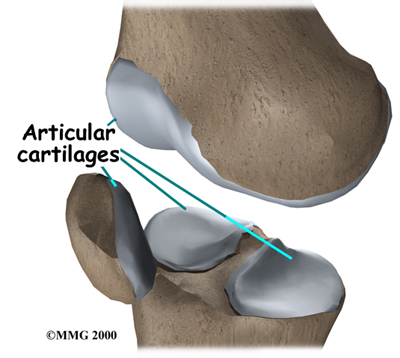
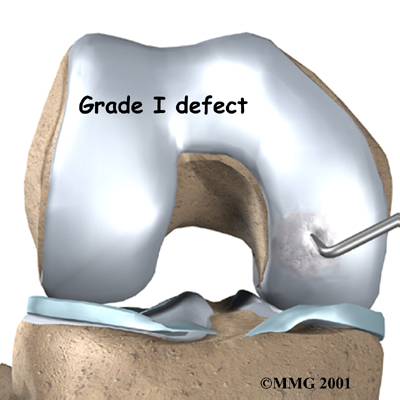
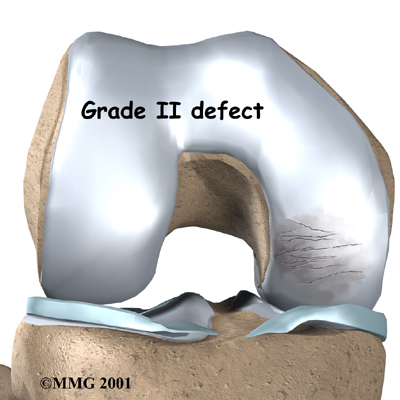
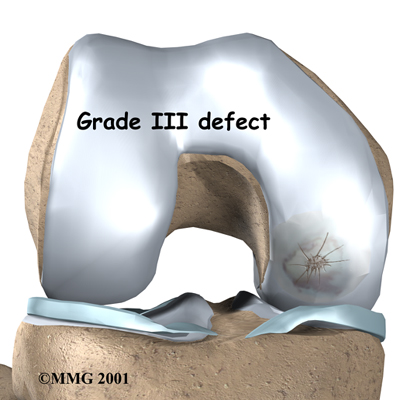


 Arthroscopic Debridement
Arthroscopic Debridement

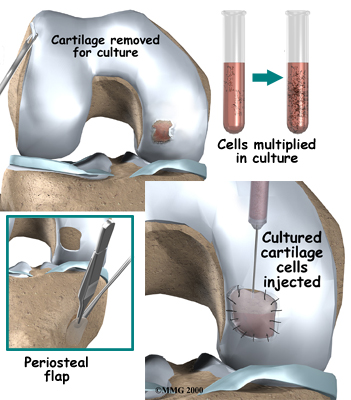
 An autograft is a procedure for grafting tissue from the patient's own body. The place where the graft is taken is called the donor site. In this case, surgeons graft a small amount of bone (osteo) and cartilage (chondral) from the donor site to put into the lesion. Usually, the donor site for this procedure is on the joint surface of the injured knee. Surgeons are careful to take the graft from a spot that won't cause a lot of problems, usually on the top and outside border of the knee cartilage. Even then, people sometimes end up with problems around the donor site. The
An autograft is a procedure for grafting tissue from the patient's own body. The place where the graft is taken is called the donor site. In this case, surgeons graft a small amount of bone (osteo) and cartilage (chondral) from the donor site to put into the lesion. Usually, the donor site for this procedure is on the joint surface of the injured knee. Surgeons are careful to take the graft from a spot that won't cause a lot of problems, usually on the top and outside border of the knee cartilage. Even then, people sometimes end up with problems around the donor site. The 